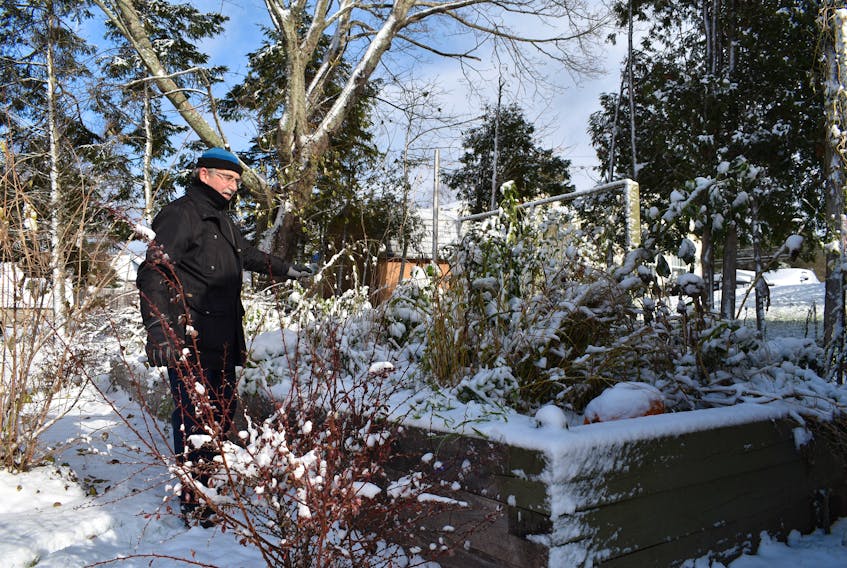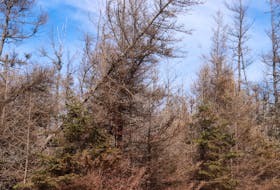SUMMERSIDE, P.E.I. — Karl Doucette loves his garden.
The retired educator has been in his Summerside home for three years and has transformed his lot into a green oasis.
Fifty varieties of roses grow alongside ornamental trees, shrubs and native plants.
“I’ve always been involved in gardening, and I’ve always liked a lot of wildlife,” said Doucette.
In a batch of ferns adopted from the Holman Ice Cream Parlour property, Doucette found a treasure - a rose sprout was tucked in with leafy acquisitions.
In two short seasons, Doucette has the bush flourishing in his special soil mixture which he makes himself.

These days, his sheds are full of empty planters and he has geranium shoots and canna lily bulbs resting in his cool, dark basement until spring.
Doucette has several large sandstone boulders throughout this property.
One huge flat stone attracts birds throughout the winter as it heats up in the sunshine.
“You don’t stop learning when you retire,” he said.
Next up on his learning list will be a monarch way station.
He has partnered with the Bedeque Bay Environmental Management Association (BBEMA) to plant a monarch butterfly way station in one corner of his yard.
Tracy Brown, BBEMA’s executive director, said the monarch population is rapidly declining.
“The monarchs are a species at risk. In the last few years, their populations have been crashing substantially,” she said.
“One issue, obviously, is the loss of their habitat.”
Around 10 years ago, common milkweed was declared an invasive species in the United States and the plant was ripped out.
But since butterflies rely on common milkweed for critical life events, the population plummeted.
Monarch facts
- Common name: Monarch butterfly
- Scientific name: Danaus plexippus
- Taxonomy group: Arthropods
- Status: Endangered (COSEWIC 2016)
- Weight: Less than 1.5 grams
- Wingspan: Seven to 10 centimetres
- Lifespan: two to six weeks, except the late summer generation which lives six to seven months, migrating and overwintering in Mexico.
- Range: British Columbia, Alberta, Saskatchewan, Manitoba, Ontario, Quebec, New Brunswick, P.E.I., Nova Scotia.
Adult monarchs breed and lay eggs on milkweed. When the caterpillars hatch, they survive exclusively on milkweed. When it’s time to cocoon, they spin a chrysalid within the milkweed leaves, said Brown.
P.E.I. has a unique chance to help out.
“On P.E.I., we don’t have common milkweed as a native [plant], we have swamp milkweed,” said Brown.
“So, our milkweed is quite unique in the fact that it doesn’t want to be high and dry. It likes to have wet feet.”
Because it prefers wet areas, milkweed won’t encroach on other crops.
“Years ago, when our farmers used to be farming right down to the edge of streams, the milkweed was ploughed out and ploughed under,” said Brown.
“Now that we have the legislation and the farmers are out of the stream, we’re working with landowners to try and go back and put the milkweed in the wetlands.”
Urban dwellers like Doucette have a big role to play, too.
“There’s more opportunity for diversity of flower populations in the city,” said Brown.
But spraying insecticides is a big deal.
“If you’re in a city, [spraying] has a bigger impact on pollinators … Because a lot of pollinators are condensed in city areas.”
Brown said rural areas can be dominated by single-crop agriculture and use, and don’t have much plant diversity.
There are about three times as many pollinators in urban landscapes as in rural areas, because of gardeners like Doucette.
For the last five years, BBEMA has been watching four monarch way stations at their offices in Emerald.
They now have enough caterpillars to share some with Doucette.
“It doesn’t matter where the caterpillars hatch,” said Brown.
“Wherever the butterfly comes out of that chrysalis, they magnetically imprint on the location and that’s where they’re going to come back to.”

The plan is to bring the caterpillars from Emerald to Doucette’s milkweed in Summerside where they will munch away before they make their chrysalis.
Doucette’s way station will conform to international standards and will be listed on monarchwatch.org.
Doucette will also plant a trial run of BBEMA’s 15-seed wildflower mix next summer.
“It’s nice to have a landowner like him that’s really dedicated,” said Brown.
Doucette watches over every part of his green kingdom with interest and attention, and Brown will consider his feedback before BBEMA puts the mixture elsewhere.
Brown is welcoming more gardeners or landowners to set up a way station.
Winter is the right time for planning, and Brown is happy to work with Islanders who want to help the monarchs.
“Sometimes we’re not saving the species, we’re saving the whole phenomenon of what that species can do and what it means,” said Brown.
“To some, it’s one flower garden. To others, it’s a whole network.”









